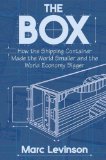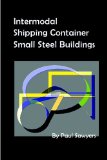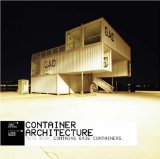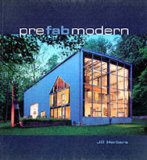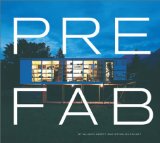Selected Books on Container Architecure, Converting Containers, Built Contaier Homes, and Prefab Architecture
|
The Box: How the Shipping Container Made the World Smaller and the World Economy Bigger
A book about the history of the shipping container? At first, one has to wonder why. (An eventuality not lost on the author, who muses "What is it about the container that is so important? Surely not the thing itself...the standard container has all the romance of a tin can.") The catch, though, is that Levinson, an economist, "treats containerization not as shipping news, but as a development that has sweeping consequences for workers and consumers all around the globe." That latter statement drives this book, which is about the economic ramifications of the shipping container-from the closing of traditional (and antiquated) ports to the rise of Asia as the world's preeminent provider of inexpensive consumer goods (distributed, naturally, using mammoth shipping containers). Levinson maintains his focus on the economics of shipping vast quantities of merchandise, organizing the book into snappy, thematic chapters on different facets of shipping ("The Trucker," and "Union Disunion," for instance), an approach that lends itself well to spot-reading. Throughout, the writing is clean-more informal than rigidly academic (union boss Teddy Gleason is "a voluble Irishman born hard by the New York docks")-making the book suitable for casual readers as well as students looking for a different take on the evolution of 20th-century world economics.
|
Intermodal Shipping Container Small Steel Buildings
Intermodal Shipping Container Small Steel Buildings explains how to purchase steel cargo containers and modify them for use as buildings under 1000 sq ft in size. Learn how you can save up to 40% over tradition lumber and factory made steel structures with these unique building blocks. New and used steel shipping containers are available nationwide. It's easy to buy containers and modify them for use as workshops, garages, cabins, guest houses, super carports, RV - 5th wheel covers, and much more (the book shows how). Enjoy a building that's up to fifty times stronger than most structures, built quick and with amazingly little labor. Take part in the shipping container building revolution with the worlds first book on the subject...Intermodal Shipping Container Small Steel Buildings! Includes photos, diagrams, plans, and charts. 116 pages, soft cover.
|
Container Architecture
A sensible answer to many of our most challenging housing problems, container architecture is the hottest thing in building today. Easy to transport, environmentally friendly, reusable and recyclable, container buildings are the home of the future today. Container Architecture presents the findings of three years of research into container architecture, showcasing more than 140 top projects with detailed full-color photographs and full resource lists. Container Architecture can hardly contain all these great ideas and innovative solutions—get it now!
|
|
Quik Build:Adam Kalkin's ABC of Container Architecture
Adam Kalkin and Quik-build llc 's book of container building variations.
|
Architecture and Hygiene
Adam Kalkin builds homes that mix performance, conceptual art, kinetic construction, and play. Here is the first monograph dedicated to the work of this controversial architectural designer and artist. Filled with Kalkin’s drawings, as well as color photos, it presents more than 30 of his buildings, projects, and installations, including The Bunny Lane House. Includes Kalkin’s witty “100 Comments Regarding Architecture and Hygiene.”
|
LOT/EK: Mobile Dwelling Unit
Since 1955, when they were first standardized, shipping containers have had a radical effect on our physical reality. Seven million of these steel containers are now moving around the world, and their measurements have defined the design of ships, railroad cars, trucks, and cargo airplanes, as well as the landscape of ports, airports, and trucking yards. And that doesn't even begin to touch on the wider and much more invisible system of distribution, of just-in-time-inventory, of information networks in which the container moves.
|
|
LOT/EK: Urban Scan
The New York-based architectural firm LOT/EK (pronounced "low-tech") has made a distinctive mark on the architectural landscape through a series of seemingly whimsical projects that make a point of using prefabricated industrial materials in unexpected ways. In their hands, a shipping container can be transformed into a mobile working unit, a museum, or a restaurant. In the process, they question our relation to the industrial environment and the artificiality of the urban landscape.
|
prefab green
IN PREFAB GREEN, architect Michelle Kaufmann shares her vision of creating thoughtful, sustainable design for everyone. Her firm, Michelle Kaufmann Designs, blends sustainable home layouts, eco-friendly materials, and low-energy options to create a "prepackaged" green solution to home design. Kaufmann tells about five eco-principles that are present in every design her firm creates-smart design, eco-materials, energy efficiency, water conservation, and healthy environment-and how each work together to create homes that make a difference.
|
prefab modern
For many, the idea of prefab housing may bring to mind trailers and other less desirable images of home life. But this idea couldn't be more wrong! Rather, the newest trends in prefab has emerged as a great way for a design- (and cost-) conscious generation to achieve the dream of home ownership. Today, prefab houses are manufactured to the highest standards of construction and aesthetics. And with the internet, these houses can be ordered from all over the world--affording people everywhere the opportunity to acquire an affordable home of distinction.
|
|
prefab
Prefab presents a series of innovative homes and concepts that boldly demonstrate that this is not your grandmother's prefab, offers a glimpse into the history of prefabricated housing over the last century, and reveals a wealth of practical and attractive alternatives to the status quo. Prefab discusses architects, builders, and designers such as Walter Gropius and Philippe Starck, examines the historical precedents from Albert Frey's Corbusier-inspired Aluminaire house to Kisho Kurokawa's capsules, and showcases the work of twenty-four contemporary architects and designers who are exploring the myriad possibilities that prefabrication offers for housing of the future. From the fantastical digitized aluminum prototypes of Gregg Lynn to the stylish functionality of Ikea's prefabricated apartments in Sweden, Prefab presents a series of innovative homes and space-saving concepts that show how far this building technique has come-and how far it can go.
|
